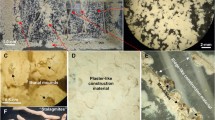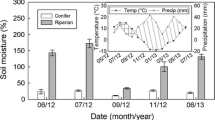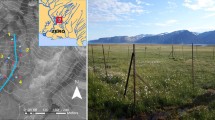Summary
We estimated the density of subterranean termites Gnathamitermes tubiformans at 800,000 · ha-1 for a standing crop biomass of 2 kg · ha-1 Predation losses were estimated to be 5,73 kg · ha-1 · yr-1 representing the major release of nutrients from termites to surficial soil layers. Nutrient fluxes from termites to predators amounted to 410g N·ha-1·yr-1, 33 g S · ha-1 · yr-1 and 19 g P · ha-1 · yr-1. These fluxes account for 8% of the litter N, 1.5% of the litter P and 2.9% of the litter S. The termites fixed an estimated 66 g · ha-1 · yr-1 atmospheric N and returned an estimated 100 g · ha-1 · yr-1 in the surface gallery carton. Since losses of elements from subterannean termites were greater than standing crops, we estimated an annual turnover of N at 3.5 times per year, P of 2.5 times per year, and S of 2.5 per times per year.
Since surface foraging, predation and alate flights are pulse regulated by rainfall, nutrient flows through subterranean termites are episodic and releases of nutrients accumulated in termite biomass preceeds or is coincident with productivity “pulses” of some shallow rooted plants. We propose that subterranean termites are important as regulators in desert nutrient cycles.
Similar content being viewed by others
References
Basalingappa S (1970) Environmental hazards to reproductives of Odontotermes assmuthi (Holmgren). Ind Sci Cong Assoc Proc 57(4): 409
Beneman JR (1973) Nitrogen fixation in termites. Science 181:164–165
Black CA (1965) Methods of soil analysis, Part 2: Chemical and microbiological properties. Amer Soc of Agron Inc Madison Wisc
Bodine MC, Ueckert DN (1975) Effect of desert termites on herbage and litter in a shortgrass ecosystem in west Texas. J Range Mgt 28:353–358
Bouillon A (1970) Termites of the Ethiopian region. In: K Krishna and FM Weesner, (eds), Biology of termites. Vol II Academic Press, NY p 154–280
Breznak JA, Brill WJ, Mertins JW, Coppel HC (1973) Nitrogen fixation in termites. Nature 244:577–580
Catana AJ, Jr (1963) The wandering quater method of estimating population density. Ecology 44:349–360
Chapin FS III, Barsdale RJ, Barel D (1978) Phosphorus cycling in Alaskan coastal tundra: a hypothesis for the regulation of nutrient cycling. Oikos 31:189–199
Chew RM (1974) Consumers as regulators of ecosystems: an alternative to energetics. Ohio J Sci 74:359–370
Cottam G, Curtis JT (1956) The use of distance measure in phytosociological sampling. Ecology 37:451–460
Eriksson E (1971) Compartment models and reservoir theory. Ann Rev Ecol Syst 2:67–84
Ettershank G, Ettershank J, Bryant M, Whitford WG (1978) Effects of nitrogen fertilization on primary production in a Chihuahuan desert ecosystem. J Arid Environ 1:135–139
Fahey TJ (1979) Decomposing lodgepole pine needles. Bull Ecol Soc Am 60:85
French JRJ, Turner GL, Bradley JF (1976) Nitrogen fixation by bacteria from the hindgut of termites. J Gen Microbiol 95:202–206
Ghilarov MS (1967) Termites of the USSR, their distribution and importance. In: Termites in the Humid Tropics, UNESCO, Paris
Hardy RFW, Burns RL, Holsten RD (1973) Applications of the acetylene-ethylene reduction assay for measurement of nitrogen fixation. Soil Biol Biochem 5:47–81
Haverty MI (1974) The significance of the subterranean termite, Heterotermes aureus, as a detritovore in a desert grassland ecosystem. Ph D diss, University of Arizona Tucson Ariz
Haverty MI, Nutting WL (1975) Natural wood preferences of desert termites. Ann Entmol Soc Amer 68:533–536
Haverty MI, Nutting WL, LaFage JP (1975) Density of colonies and spatial distribution of foraging territories of the desert subterranean termite, Heterotermes aureus (Snyder), Environ Entomol 4:105–109
Haverty MI, Nutting WL, LaFage JP (1976) A comparison of two techniques for determining abundance of subterranean termites in an Arizona desert grassland. Insectes Sociaux 23:175–178
Houghton FE (1972) Climatic guide, New Mexico St. Univ., Las Cruces, New Mex, 1851–1971. New Mex Agr Res Rep 230:1–20
Johnson KA, Whitford WG (1975) Foraging ecology and relative importance of subterranean termites in Chihuahuan desert ecosystems. Environ Entomol 4:66–70
Kitson RE, Mellon MG (1944) Colorimetric determination of phosphorus as molybdivanadophosphoric acid. Anal Chem 16:379–383
Kleiner D (1975) Fixation of atmospheric nitrogen by microrganisms. Angew Chem Int Ed 14:80–84
LaFage JP, Haverty MI, Nutting WL (1976) Environmental factors correlated with the foraging behavior of a desert termite Gnathamitermes perplexus (Banks) (Isoptera: Termitidae). Sociobiol 2:155–169
Lee KE, Wood TG (1971) Termites and Soils. Academic Press, London, Great Britain
Ludwig JA, Reynolds JF, Whitson PD (1975) Size-biomass relationships of several Chihuahuan desert shrubs. Amer Midl Natur 94:451–461
Mattson WJ, Addy ND (1975) Phytophogous insects as regulators of forest primary production. Science 190:515–522
McNabb DH, Geist JM (1979) Acetylene reduction assay of symbiotic nitrogen fixation under field conditions. Ecology 60(5):1070–1073
Nes P (1979) Routine measurement of total sulfur in biological material. N Zeal J Sci 22:269–272
Noy-Meir I (1979) Desert ecosystems: Higher trophic levels. Ann Rev Ecol Syst 5:195–214
Nutting WL (1969) Flight and colony foundation. In: Krishna and FM Weesner, eds. Biology of Termites, Vol I. Academic Press New York p 233–283
Nutting WL, Haverty MI (1976) Seasonal production of alates by five species of termites in an Arizona desert grassland, Sociobiology 2:145–153
O'Brien RT (1978) Proteolysis and ammonification in desert soils. In: NE West and J Skujins (eds), Nitrogen in Desert Ecosystems. Dowden, Hutchinson and Ross, Inc. Strousburg, Penn p 50–59
Pianka ER (1973) The structure of lizard communities. Ann Rev Ecol Syst 4:53–74
Pomeroy LR (1970) The strategy of mineral cycling. Ann Rev Ecol Syst 1:171–190
Potts M, Krumbein WE, Metzger J (1978) Nitrogen fixation in anaerobic sediments determined by acetylene reduction, a new 15N field assay, and simultaneous total N-15N determination. In: WE Krumbein (ed), Environmental Biogeochemistry and Geomicrobiology. Vol 3: Methods, metals and assessment. Ann Arbor Science Publishers Inc. Ann Arbor Mich
Rehder H, Schäfer A (1978) Nutrient turnover studies in alpine ecosystems: IV. Communities of the central Alps and comparative survey. Oecologia (Berl) 34:309–327
Reiners WA (1972) Structure and energetics of three Minnesota forests. Ecol Monogr 42:71–94
Schaefer DA, Whitford WG (1979) Nitrogen fixation in desert termites. Bull Ecol Soc Am 60:128
Sokal RR, Rholf FJ (1969) Biometry WH Freeman and Co San Francisco
Spears BM, Ueckert DN, Whigham TL (1975) Desert termite control in short-grass prairie: Effect on soil physical properties. Environ Entomol 4:899–904
Stark N (1972) Nutrient cycling pathways and litter fungi. Bio-science 22:355–360
Steppe W (1976) Intervertebrate predation on termites of the African savannah. Insectes Sociaus 17:205–218
Stewart BA, Porter LK, Beard WE (1969) Determination of total nitrogen and carbon in soils by a commercial Dumas apparatus. Proc Soil Sci Soc Amer 28:269–272
Whitford WG, Ettershank G (1975) Factors affecting foraging activity in Chihahuan desert harvester ants. Environ Entomol 4:689–696
Whitford WG (1978) Foraging in seed-harvester ants Pogonomyrmex spp. Ecology 59:185–189
Whitford WG (1978b) Structure and seasonal activity of Chihuahuan desert ant communities. Insectes Sociaux 25:79–86
Whitford WG, Depree E, Johnson P (1981) Foraging ecology of two Chihuahuan desert ant species: Novomessor cockerelli and Novomessor albisetosis. Insectes Sociaux 27:148–156
Wilson EO (1971) The insect societies. Harvard Univ Press Cambridge Mass
Wood TG, Sands WA (1978) The role of termites in ecosystems. In: MV Brian, (ed), Production Ecology of Ants and Termites. Cambridge Univ. Press, Cambrdige, Great Britain p 245–292
Author information
Authors and Affiliations
Rights and permissions
About this article
Cite this article
Schaefer, D.A., Whitford, W.G. Nutrient cycling by the subterranean termite Gnathamitermes tubiformans in a Chihuahuan desert ecosystem. Oecologia 48, 277–283 (1981). https://doi.org/10.1007/BF00347977
Received:
Issue Date:
DOI: https://doi.org/10.1007/BF00347977




